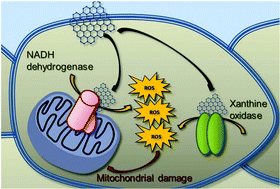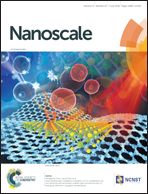Graphene and graphene oxide induce ROS production in human HaCaT skin keratinocytes: the role of xanthine oxidase and NADH dehydrogenase†
Abstract
The extraordinary physicochemical properties of graphene-based nanomaterials (GBNs) make them promising tools in nanotechnology and biomedicine. Considering the skin contact as one of the most feasible exposure routes to GBNs, the mechanism of toxicity of two GBNs (few-layer-graphene, FLG, and graphene oxide, GO) towards human HaCaT skin keratinocytes was investigated. Both materials induced a significant mitochondrial membrane depolarization: 72 h cell exposure to 100 μg mL−1 FLG or GO increased mitochondrial depolarization by 44% and 56%, respectively, while the positive control valinomycin (0.1 μg mL−1) increased mitochondrial depolarization by 48%. Since the effect was not prevented by cyclosporine-A, it appears to be unrelated to mitochondrial transition pore opening. By contrast, it seems to be mediated by reactive oxygen species (ROS) production: FLG and GO induced time- and concentration-dependent cellular ROS production, significant already at the concentration of 0.4 μg mL−1 after 24 h exposure. Among a panel of specific inhibitors of the major ROS-producing enzymes, diphenyliodonium, rotenone and allopurinol significantly reverted or even abolished FLG- or GO-induced ROS production. Intriguingly, the same inhibitors also significantly reduced FLG- or GO-induced mitochondrial depolarization and cytotoxicity. This study shows that FLG and GO induce a cytotoxic effect due to a sustained mitochondrial depolarization. This seems to be mediated by a significant cellular ROS production, caused by the activation of flavoprotein-based oxidative enzymes, such as NADH dehydrogenase and xanthine oxidase.

- This article is part of the themed collections: Graphene Turns 15: Bio-implications and Bio-applications and 2018 Nanoscale HOT Article Collection


 Please wait while we load your content...
Please wait while we load your content...